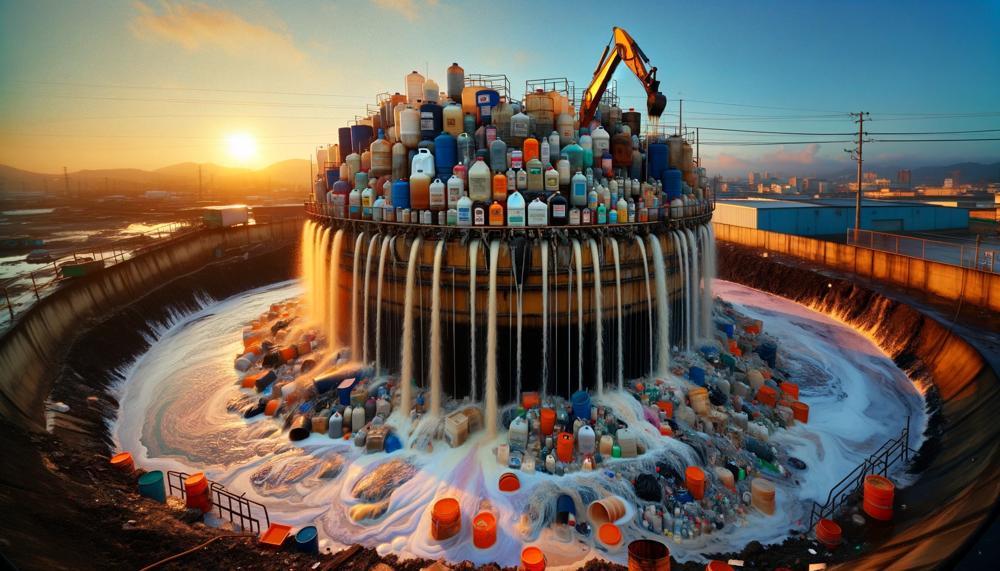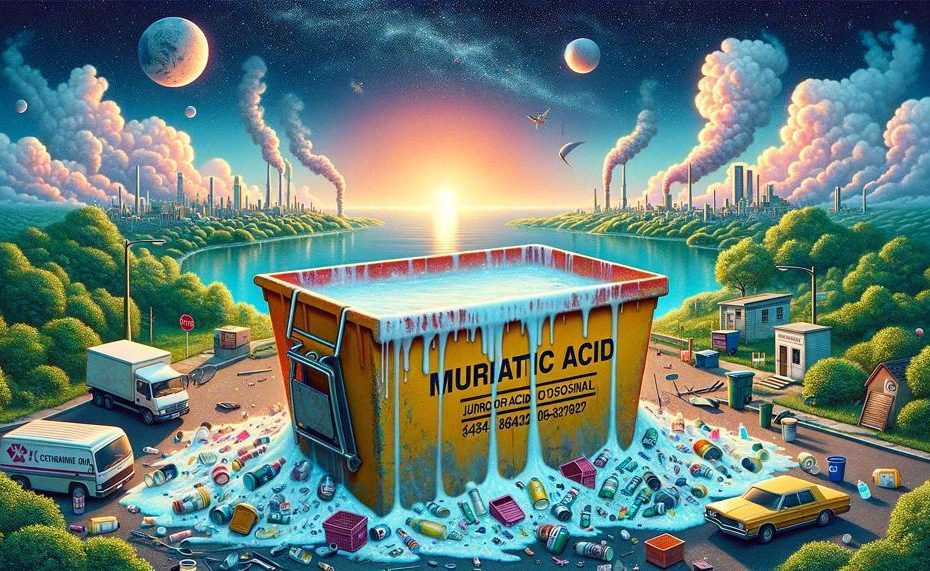One of the most potent chemicals we often come into contact with while doing do-it-yourself tasks or maintaining a swimming pool is muriatic acid. This material, well-known for its potent cleaning properties, is a major player in the home renovation industry.
But enormous power also entails great responsibility, particularly when it comes to bidding our acidic ally farewell.
This blog article is your go-to resource if you’ve ever had leftover muriatic acid and are unsure of what to do next.
We’re breaking down the essentials of muriatic acid disposal in a way that’s easy to digest, yet doesn’t skimp on the crucial details.
So, how do you dispose of muriatic acid properly?
Here are some ways to dispose of muriatic acid:
- Dilute and pour down the drain: Dilute ¼ cup of muriatic acid with 2 gallons of water, then pour it down the drain if local regulations allow it.
- Neutralize and pour down the drain: Neutralize 1 gallon of acid by mixing in 5.5 pounds of baking soda, then pour it down the drain.
- Use it for cleaning: Use leftover muriatic acid to clean brick, concrete, toilets, and tile. You can also use it to balance your pool’s pH.
- Take it to a hazardous waste facility: Give leftover muriatic acid to a local hazardous waste facility.
- Pour it into the toilet: Pour it into your toilet and flush right away. Repeat until it’s all flushed. Rinse the bucket three times and flush that. Then flush five times.
You can also neutralize muriatic acid with a basis, like baking soda or garden lime. However, this produces dangerous gaseous chlorine as a side product.
You should not pour muriatic acid outside or down a storm drain.
Let’s dive in and demystify the process, ensuring you’re equipped with the knowledge to handle muriatic acid responsibly.
Contents
- 1 What is Muriatic Acid?
- 2 Is It Safe to Pour Muriatic Acid Down the Drain?
- 3 Why is it Important To Safely Dispose of Muriatic Acid?
- 4 Safety Precautions to Take While Handling Muriatic Acid
- 5 6 Methods of Disposing Muriatic Acid
- 6 Best Methods of Safely Neutralizing Muriatic Acid
- 7 How to Safely Store Muriatic Acid?
- 8 What Not To Do When Disposing of Muriatic Acid
- 9 Conclusion
What is Muriatic Acid?
Muriatic Acid, known scientifically as Hydrochloric Acid, is a potent chemical with widespread applications, from household cleaning to swimming pool maintenance. Its highly corrosive nature allows it to tackle tough stains, clear out excess grout, and adjust pool pH levels.
However, its strength isn’t without risks; improper handling can lead to severe skin burns and respiratory issues, underscoring the necessity for meticulous disposal.
Is It Safe to Pour Muriatic Acid Down the Drain?
No, it’s downright risky to pour muriatic acid down the drain. This potent cleaner might do wonders for pool maintenance, yet it’s a menace for your pipes and the environment.
Why Not the Drain?
Muriatic acid’s ferocity isn’t just a tale; it’s a fact. Designed to battle stubborn stains and lower pH levels, its power extends far beyond cleaning, veering into the realm of potential pipe havoc and environmental chaos.
- Pipe Damage: Imagine the insides of your pipes as resilient soldiers. Muriatic acid, however, is a battle they cannot win. It can eat away at the pipes, leading to costly damages.
- Health Hazards: The unseen danger lies in its fumes. Pouring it down the drain risks releasing harmful gases that can besiege your home, threatening your family’s health.
- Environmental Threat: Beyond your home, this acid can journey through the drains, reaching and ravaging aquatic ecosystems.
Safe Disposal Tactics
Handling muriatic acid with the care it demands involves a few steps, outlined below in a straightforward manner. Remember, safety first is not just a saying; it’s a necessity.
| Step | Action | Purpose |
| 1 | Neutralize | To reduce its corrosiveness before disposal. |
| 2 | Check local regulations | Ensures compliance with specific disposal guidelines. |
| 3 | Contact hazardous waste facility | Safe and environmentally responsible disposal. |
Why is it Important To Safely Dispose of Muriatic Acid?
Disposing of muriatic acid with care isn’t just a good practice; it’s essential for the safety of our communities and the well-being of our planet. Here’s why:
Safety First
Muriatic acid, a potent substance known for its cleaning prowess, especially in pools, is not to be trifled with. Mishandling can lead not only to immediate physical harm but also to long-term environmental damage.
Here’s the lowdown on the risks and why proper disposal is non-negotiable:
Health Hazards
| Risk | Impact | Prevention |
|---|---|---|
| Skin Burns | Direct contact can cause severe skin burns. | Proper protective gear and careful handling. |
| Respiratory Problems | Inhalation of vapours can lead to respiratory issues. | Ensure adequate ventilation; never mix with other chemicals. |
| Eye Damage | Splashes can cause serious eye damage. | Wear safety goggles during handling and disposal. |
Environmental Concerns
| Aspect | Effect | Solution |
|---|---|---|
| Water Pollution | Contaminates waterways, harming aquatic life. | Follow local guidelines for hazardous waste disposal. |
| Soil Degradation | Alters soil chemistry, affecting plant life. | Use neutralizing agents before disposal, if permitted. |
| Air Quality | Releases harmful gases, affecting air quality. | Properly seal and label containers for disposal. |
Failing to dispose of muriatic acid properly can lead to catastrophic outcomes, not just for the immediate environment but also for the broader community. It’s a substance that demands respect and responsibility. Whether it’s ensuring personal safety by donning the right gear or protecting Mother Nature by following the book on disposal, every step taken is a stride towards a safer world.
Moreover, the potential legal ramifications for mishandling hazardous waste like muriatic acid can’t be ignored. It’s not just about doing right by the planet but also about adhering to laws designed to keep us all safe.
Safety Precautions to Take While Handling Muriatic Acid
Handling muriatic acid, a potent chemical with widespread applications, demands adherence to stringent safety protocols to mitigate risks. Here’s how you can ensure safety while using this substance:
Gear Up for Safety
- Wear Protective Clothing: Long sleeves and pants shield your skin from spills.
- Gloves and Goggles: Acid-resistant gloves and safety goggles are non-negotiable to prevent skin and eye contact.
- Respiratory Protection: In poorly ventilated spaces, a face mask or respirator guards against inhaling harmful fumes.
Mixing and Application: A Delicate Dance
- Ventilation is Key: Always work in an area where air can circulate freely.
- Dilution Directions: Add acid to water, not the other way around, to prevent dangerous reactions.
- Use Tools Wisely: Employ acid-resistant tools and containers to avoid unexpected breakdowns.
Storage and Disposal: Guarding Future Safety
- Keep It Original: Store muriatic acid in its original container, ensuring the cap is secure.
- Out of Reach: Place it where curious hands and paws can’t find it.
- Disposal Wisdom: Consult local hazardous waste guidelines for proper disposal methods.
In Case of Emergency: Quick Response
- Immediate Rinse: Any spill on your skin or eyes? Flush with plenty of water.
- Seek Medical Attention: If irritation persists after exposure, professional medical help is crucial.

Alternatives and Caution
- Softer Options Exist: Research less harsh cleaners for less risky cleaning jobs.
- Concrete and Rust: Apply with extra care when tackling rust stains on concrete to avoid damage.
6 Methods of Disposing Muriatic Acid
Disposing of muriatic acid, a substance known for its potent corrosiveness, demands meticulous care. Below, find six sanctioned strategies for its safe disposal, ensuring harm neither to humans nor our environment befalls.
| Method | Description | Precautions |
| Neutralization with Baking Soda | Gradually introduce baking soda to the muriatic acid until effervescence ceases. | Perform in a well-ventilated area; wear gloves and eye protection. |
| Dilution with Water | Dilute the acid by slowly adding water to it, reducing its concentration. | Always add acid to water, not vice versa, to prevent splashing. |
| Neutralization with Lime or Limestone | Use lime or limestone to neutralize the acid, forming harmless compounds. | Handle with care as the reaction can be exothermic and might cause splattering. |
| Solidification | Absorb the acid using materials like kitty litter, then dispose of as a solid. | Ensure the mixture is thoroughly dry before disposal in a sealed container. |
| Professional Chemical Disposal | Engage a specialized service for handling and disposing of hazardous chemicals. | Best for large quantities or when in doubt about safe disposal methods. |
| Storage for Future Use | If reuse is anticipated, store safely in a cool, well-ventilated area, clearly labelled. | Ensure the container is sealed tightly to prevent leaks or spills. |
Remember, safety’s paramount. Gear up with protective attire, keep your workspace airy, and never mix chemicals without proper knowledge.
Best Methods of Safely Neutralizing Muriatic Acid
To safely neutralize muriatic acid, also known as hydrochloric acid, employing common substances such as baking soda or ammonia is both effective and straightforward.
Given its corrosive nature, handling muriatic acid demands caution, necessitating protective gear like gloves and goggles. Here’s a succinct guide:
Neutralizing with Baking Soda (Sodium Bicarbonate):
Preparation: Don protective gear to shield against potential splashes and fumes.
Process:
- In a vessel, mix water and baking soda to form a paste.
- Gradually introduce this paste into the muriatic acid, stirring constantly.
- Continue until fizzing ceases, indicating neutralization.
Neutralizing with Ammonia (Ammonium Hydroxide):
Preparation: Equally, ensure you’re well-protected.
Process:
- Dilute ammonia in water to achieve a 10% solution.
- Slowly mix this solution with the muriatic acid.
- Stir until no more reactions occur, signifying a neutral pH.
Safety Notes:
- Operate in areas with ample ventilation.
- Avoid inhaling fumes by wearing a mask.
- Mix gradually to prevent excessive heat and fumes.
Disposal Advice:
After neutralization, the solution is less harmful but still requires proper disposal. Contact local hazardous waste facilities for guidance.
| Method | Substance Used | Key Considerations |
| Baking Soda | Sodium Bicarbonate | Accessible, safe for small quantities |
| Ammonia | Ammonium Hydroxide | Effective for larger volumes, needs dilution |
| Commercial Products | Sodium/Calcium Carbonate | Convenient for industrial use, might be pricier |
Using these methods, neutralizing muriatic acid can be done effectively, safeguarding both the handler and the environment.
How to Safely Store Muriatic Acid?
Storing muriatic acid safely is crucial to avoid risks to health, the environment, and property.
| Safety Measure | Details | Reason |
| Container Material | HDPE plastic or glass | To resist corrosion |
| Storage Location | Cool, dry, and dark | Prevents deterioration |
| Labeling | Warning labels, product info | Avoids confusion and mishaps |
| Chemical Isolation | Store away from other chemicals | Prevents dangerous reactions |
| PPE Usage | Gloves and goggles | Protects from spills and splashes |
| Ventilation | Well-ventilated area | Avoids inhalation of fumes |
| Disposal | Contact local authorities | Ensures safe disposal |
What Not To Do When Disposing of Muriatic Acid
When it comes to the chore of disposing of muriatic acid, one must tread carefully, ensuring not a step is misplaced. This potent chemical, a staple in both industry and domestic cleaning, demands respect for its hazardous nature. The task is not for the faint-hearted, but with the right knowledge, it can be managed safely. Let’s delve into the essentials of what not to do, ensuring both you and the environment stay clear of harm’s way.
Do Not Disregard Personal Protective Equipment (PPE)
Wearing the correct protective gear is non-negotiable. This includes gloves, goggles, and a face mask to shield you from splashes and harmful fumes.
Avoid Poor Ventilation
Always work in an area with ample airflow. Confined spaces can trap fumes, posing a significant inhalation risk.
Never Mix with Other Chemicals
Mixing muriatic acid with other substances can lead to violent reactions. The combination of bleach and muriatic acid, for instance, releases toxic chlorine gas.
Do Not Pour Down Drains
Disposing of muriatic acid in your sink or toilet can damage plumbing and harm the water treatment process, affecting wildlife and ecosystems.
Steer Clear of Inadequate Neutralization
Neutralizing the acid improperly can result in dangerous spills. Use baking soda or a commercial neutralizer, ensuring the reaction is complete before disposal.
Bypass Incorrect Disposal Methods
Contact local waste management authorities for guidance on hazardous waste disposal sites. Improper disposal risks environmental and human health.
| Don’ts | Why Not | Safe Alternative |
| Ignore PPE | Risk of burns and inhalation injuries | Always wear gloves, goggles, and masks |
| Dispose in household drains | Can damage plumbing and harm water ecosystems | Contact local hazardous waste disposal |
| Mix with other chemicals | Potential for hazardous reactions | Dispose of separately following guidelines |
| Poor ventilation | Inhalation risk from fumes | Use in well-ventilated or outdoor areas |
| Inadequate neutralization | Could lead to dangerous chemical reactions | Properly neutralize before disposal |
Conclusion
The proper disposal of muriatic acid requires a combination of expertise, prudence, and compliance with legislation to protect people and the environment. Although muriatic acid is quite useful for cleaning homes and maintaining pools, it may be dangerous if used improperly. Understanding its corrosive nature and the possible threats it causes is essential to appropriate disposal.
First things first: get acquainted with local disposal regulations, which differ depending on where you live. These rules aim to safeguard our ecosystems from damage in addition to ensuring public safety. A vital step in minimizing the acid’s potency and lowering the possibility of negative responses is to dilute it appropriately. This ensures that the acid is less forceful before it is neutralized, much like cushioning a blow.
Using materials like baking soda or ammonia to neutralize muriatic acid reduces it from a potent enemy to a controllable one. In order to reduce its influence on the environment and make disposal safer, this step is crucial. The proper disposal techniques are essential; this is a job best left to a professional facility rather than the sewage system to prevent damage to ecosystems or infrastructure.
A thorough cleansing after disposal guarantees that there are no leftovers that might endanger you or the environment. If you approach this procedure with the seriousness it requires, disposing of muriatic acid will demonstrate your dedication to environmental preservation and safety.





